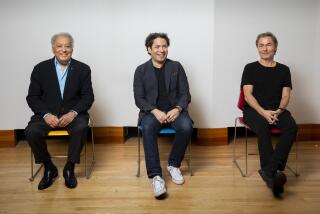MUSIC REVIEW : E.A.R. Unit Opens at Museum
Often, programing new music with older works helps introduce progressive ideas by comparing them to familiar ideas from the past. Yet in these conservative times, the music of the past is often more iconoclastic than that of todayâs composers.
Or so it seemed when the California E.A.R. Unit opened its second season in residence at the County Museum of Art on Wednesday night with two world premieres and three often-performed works from the early 1970s. The well-attended event in Bing Theater was the 100th concert by the nine-member ensemble.
Stephen Moskoâs âFor Morton Feldmanâ displayed a carefully knit fabric of whimsical motivic structuring, delicately presented by a flute-piano-cello trio. The carefully constructed, skilled writing aptly reflected Moskoâs influences from the late Feldman, while rarely escaping a safe, academic style.
Dorothy Stone demonstrated deep understanding and dedication, performing on flute, bass flute and piccolo. Pianist Gaylord Mowry and cellist Erika Duke followed with equal devotion to detail.
In Rand Steigerâs â13 Loops,â an abundance of tremolos, trills and simple rhythms maintain different but regular pulses, resulting in a satisfying layering of elements, from a flute solo at the beginning through a final massed acceleration.
Again, Stoneâs stunning flute work defined and carried most of the piece, while Moskoâs spare conducting of the seven-performer mixed ensemble also contributed. Steiger manned a setup emitting subtle electronic effects that most of the time remained in the background.
But most of the eveningâs vitality rested in the older stuff. The music of Steve Reich, Karlheinz Stockhausen and Frederic Rzewski often shows up on the E.A.R. Unitâs programs, but this selection was especially good.
A surprisingly multifarious performance of Reichâs âMusic for Pieces of Woodâ used five sets of different-size claves, filling the room with an intoxicatingly hypnotic pulse. The result was ebullient and accurate.
A laudable performance of Stockhausenâs âTierkreis,â arranged routinely but appropriately by Art Jarvinen for the ensembleâs full forces, brought life to the enigmatic, singable melodies, while the repetitive patterns of Rzewskiâs âComing Togetherâ exuded energy and power, making it the eveningâs showstopper.
More to Read
The biggest entertainment stories
Get our big stories about Hollywood, film, television, music, arts, culture and more right in your inbox as soon as they publish.
You may occasionally receive promotional content from the Los Angeles Times.










